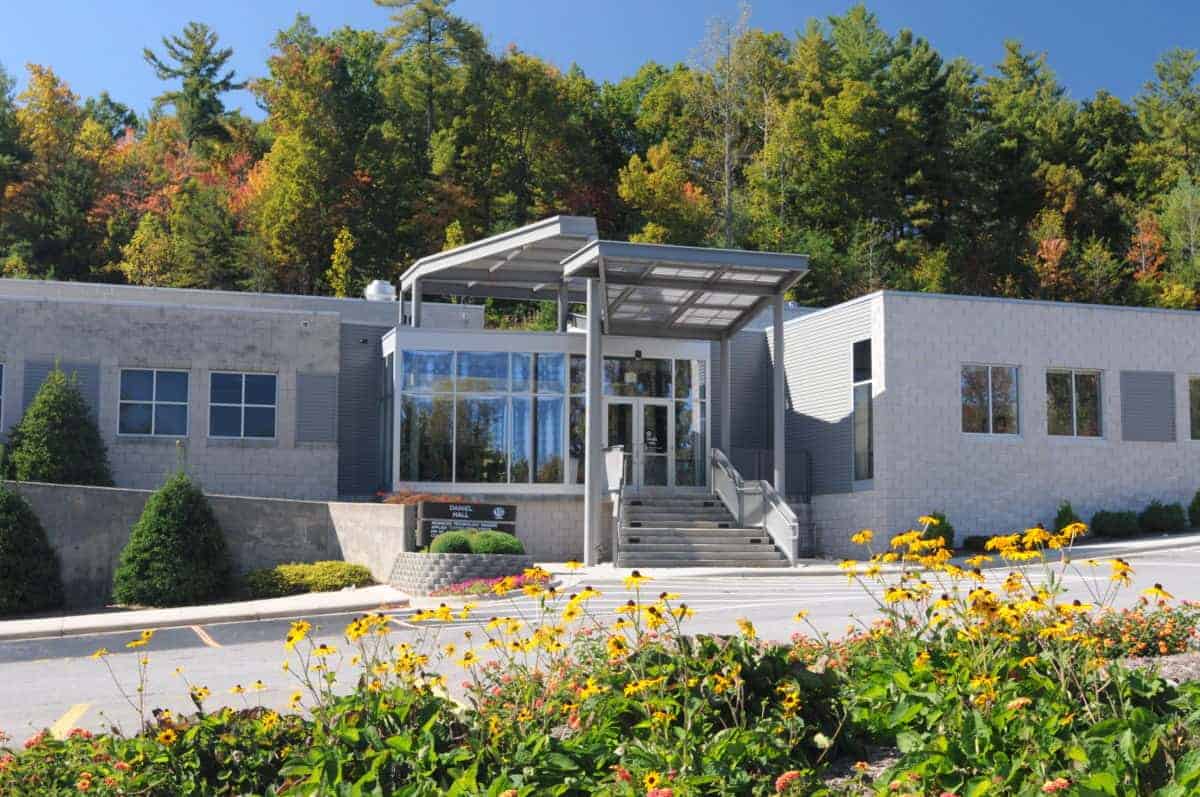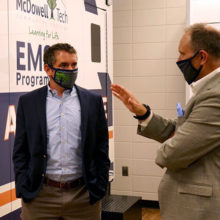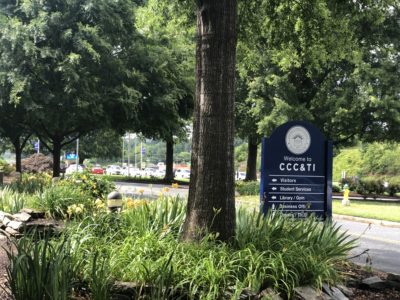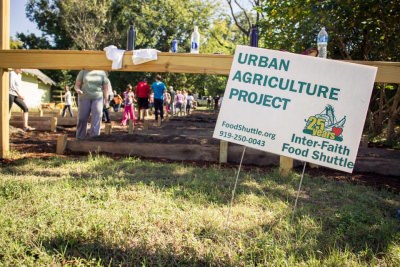The first NASCAR race I ever attended was at North Wilkesboro Motor Speedway. My adopted dad was a fan of Dale Earnhardt, so naturally I chose to pull for Jeff Gordon. The first large scale festival I ever attended was the Brushy Mountain Apple Festival in North Wilkesboro. It also happened to be the first time I ever tried Dippin’ Dots, which was then dubbed the ice cream of the future, and it was revelatory. Large crowds, deep fried apple pies, and Dippin’ Dots. What more do you need?
During those days, North Wilkesboro was also the home of Lowe’s Home Improvement corporate headquarters — a homegrown success story of a national size and scope.
But the old Motor Speedway is a relic now, the roars of NASCAR long since moved on to major cities around the country. Lowe’s moved their corporate headquarters to Mooresville in 2005.
Along the way, Wilkes County endured the second worst drop in annual income from 2005 to 2015 according to Jeff Cox, President of Wilkes Community College. Wilkes Community College also serves Ashe and Alleghany County. Across their three-county service area, two of every three kids born into poverty will remain there.
It isn’t all doom and gloom despite the challenges. The unemployment rate now sits at 3.7 percent in Wilkes County, although no one has grown enough to replace the decline of white collar jobs brought on by the departure of Lowe’s corporate headquarters.
Each spring banjos twang during the annual MerleFest Music Festival, which brings tens of thousands to the region. Those crowds gather on the campus of Wilkes Community College and spill out across Wilkesboro. The Brushy Mountain Apple Festival remains — hopefully with fried apple pies and Dippin’ Dots still intact, although I haven’t been back in a while.
My home region still has natural beauty and outdoor activities galore. Appalachian State University, which sits 45 minutes up the road, has become a robust economic engine for a thriving Watauga County. Retirees are flocking to much of the region, at least for the summer months and leaf season.
And after generating headlines in 2007 for being the county with the third highest rate of overdose deaths in the country, they are now heralded for Project Lazarus which has emerged as a trailblazer in fighting opioids through a combination of collaboration, marketing, and investing in data.
Given the cards they were dealt, one might expect cynicism from the region. They have, after all, been hammered by global and national economic trends, which were in many ways beyond their control. Despite these challenges, as President Cox and his team showed us around campus recently, they continually struck an optimistic note.
The question before them is whether or not they can build off of their assets and build a road map for how a rural community can recover.
Wilkes Community College’s vision for the future
Wilkes Community College (WCC) welcomed us with an impressive spread from their culinary program. As we munched on peanut brittle and caramel, President Cox walked us through their new strategic plan, which is designed to deal with the challenges of economic decline and social mobility.
In the opening letter of the strategic plan, Cox writes:
“Despite these challenges, I believe we have everything we need right here in our community to build a better tomorrow. Our history and heritage were shaped by strong, determined folks who built their own homes, dug their own mountain wells, and created their own livelihoods — fueled and supported by the tight-knit community around them. That heritage of resilience and community is still with us today.”
As the quote indicates, the plan is rooted in place.
The WCC team met with over 200 community leaders and engaged more than 3,500 stakeholders across the region. They then brought community feedback together with national, regional, and statewide data to create benchmarks and reflect best practices in the plan.
President Cox is currently an Aspen Community College President Fellow, and his team baked their framework for community colleges into the strategic plan. The Aspen framework includes the following elements:
- Completion and transfer
- Equity
- Learning
- Labor market outcomes
What will this framework look like for Wilkes Community College? One clue is the pillar of community enhancement which President Cox and his team added to the Aspen framework as part and parcel of the work.
They plan to bolster their overall completion rate. They also intend to focus on building successful pathways and supports for their transfer students. President Cox struck perhaps the boldest note of the day when he stated he believes they can move their completion rate to 50 percent, which would require effectively doubling their current completion rate and set the pace for two-year institutions in the state. They are implementing the guided pathways model; strengthening partnerships with K-12 districts, other community colleges, and four-year institutions; and constantly evaluating their credential offerings to match them to the labor market.
Here is the presentation President Cox delivered during our visit:
On the equity front, their strategic plan calls for increased attention to student financial aid and the “full cost of education.”
Research and conversation in the postsecondary space has lately been shifting to look at the needs of an evolving postsecondary student population, which to a greater degree features students who are older, more independent of their parents financially, and more likely to have children. Given this, the WCC emphasis around the full cost of education would be meeting a real need if executed well.
What’s next
Of course, the best plan in the world doesn’t matter without execution. To that end, President Cox and his team have built out a strategy around implementation that includes annual implementation plans and teams tied to each goal.
As they state in the report, “We define ‘SMART Strategies’ as Specific, Measurable, Achievable, Relevant, Time-bound initiatives that are supported by data and analysis in their alignment with the college’s long-term goals and objectives. Each academic year over the strategic plan’s five year period, the college will review progress made, lessons learned, resources available, and evolving circumstances in order to adjust or add SMART Strategies for implementation that best accomplish the goals and objectives set forth to benefit students and communities it serves.”
For more details, dig into the annual implementation plan below:
Why this matters
Strategic plans, even those with implementation plans attached to them, are a dime a dozen. So, why does this plan matter?
For one, the plan is bold.
If Wilkes Community College more than doubles their completion rate, this will hold lessons for the entire state. Critics of community colleges often point to low completion rates at community colleges, which is one reason to monitor Wilkes’ progress in boosting completion, along with the work of efforts such as Finish First at Wake Tech.
Secondly, the plan aims to cement and expand the role of Wilkes Community College as an anchor in their community. The plan focuses on community engagement and enhancement with activities ranging from connecting an aging population to the institution via a focus on lifelong learning, diversifying and ramping up support for community events such as MerleFest, and enhancing publicly available recreational facilities to serve the needs of the community.
And, finally, a big part of the equation for the college will be changing perceptions and improving awareness of the opportunities the institution provides. Even Cox has wrestled with this in his own household as he describes:
At the 2018 NC Community College Conference, numerous speakers referenced community colleges as the “economic engine” for our workforce and communities. While it appears unlikely that North Wilkesboro Motor Speedway will make a comeback any time soon, if Wilkes’ strategic plan proves successful, the economic engines may begin to roar yet again.





